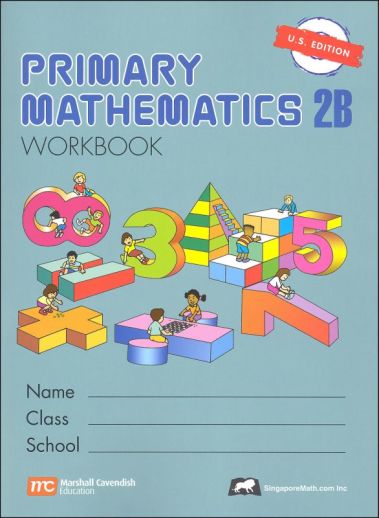We use cookies to make your experience better. To comply with the new e-Privacy directive, we need to ask for your consent to set the cookies. Learn more.
Primary Math US 2B Workbook
Workbooks provide further practice for students to complete independently in conjunction with textbook exercises. This essential component reinforces learning to create a solid foundation in elementary math.
Note: Two workbooks (A and B) for each grade correspond to the two halves of the school year. Soft cover.
I'll admit, my initial reaction to this program was skeptical. The textbooks are thin and have a straightforward, no-nonsense appearance. Texts switch from full-color to two-toned pages after second grade, and all workbooks are printed in black and white. After spending a great deal of time evaluating the program's contents, however, my opinion has improved considerably. Primary Math uses a concrete-to-pictorial-to-abstract approach to teaching. Concrete illustrations are incorporated heavily in the early grades, gradually giving way to more abstract representations so that math is learned meaningfully. The program builds strong problem solving, critical thinking, and computational skills through well-chosen practice problems.
Each grade consists of two semester sets to be completed in one year. For example, the complete first grade curriculum requires the 1A and 1B textbooks (non-consumable) and the 1A and 1B workbooks (consumable). Workbook assignments are directly correlated with each textbook. Small arrows, usually located in the lower left hand corner of a page, specify when to pause in the text and what exercise number to complete.
Brief teacher's instructions are provided in each textbook's preface, which I highly suggest reading. Although the pace of the course really depends on the individual student, 2-3 pages in the text is usually enough for one day's lesson. To effectively use the textbook, the teacher should study the examples ahead of time in order to determine the best way to verbally explain a concept to the student. Teacher-student or student-student discussions are an important part of this program. Unfortunately, the text doesn't tell you how to facilitate discussions. Fortunately, there are now Teacher Guides and Home Instructor Guides available for all levels.
Both the Teacher Guides and the Home Instructor Guides include answers to the textbook and workbook problems. Both of these publications help teachers understand the course material and provide suggestions to help you introduce concepts. As a general rule, the TGs are more oriented to the classroom while the HIGs are more geared to working one-on-one with a student. However, both provide detailed lesson plans. The TGs have daily lesson plans while the HIGs provide teaching segments indicating the number of weeks to spend per unit. A significant difference between the two is that the HIGs have a sidebar column that shows assignments complete with answers and often solutions. Assignments in the TGs are listed within the lesson plans and all answers are in the back of the book. Also included in the appendix of each are mental math worksheets and some teaching helps. Answers (but no solutions) to the U.S. edition textbooks and workbooks are also available in separate answer key booklets. For convenience, we have put together sets for each grade and semester that include the text, workbook and HIG.
TGs and HIGs both include lists of suggested manipulatives and materials. (please see our Singapore Math Manipulative category at the end of the Singapore Math section.
Extra practice sets are included in all textbooks, except first grade. These problem sets are optional and should be done only after the workbook exercises for that section have been completed. Cumulative review sections are also incorporated into the text, although not on a daily basis like Saxon. Review sections are also included in each workbook. Although these problem sets are optional, I would strongly suggest completing the extra practice. Some of the review sets are quite lengthy, and you might want to consider devoting a day's lesson to review whenever a longer set arises. I suspect a key factor to this program's success in Singapore is that students are both motivated and expected to practice their math skills through homework and optional problem sets use is strictly up to the teacher, although Primary Math tends to emphasize mental calculations.
While some believe that Primary Math contains "just the right amount of practice", others believe not enough is provided. For students who feel they need more practice to really "own" a concept or skill, a variety of supplements, specifically designed to complement Primary Math, are available.
Compared to Saxon Math, Primary Math encompasses a narrower scope. While Saxon Math covers coordinate graphing, negative numbers, square roots, and probability, these topics are omitted from Primary Math and are not covered until New Elementary Math. The smaller scope, however, allows the program to emphasize the basics. Primary Math focuses on the four arithmetic operations (using whole numbers, fractions, and decimals), perimeter, area, volume, angles, quadrilaterals, symmetry, time, length, weight, money, graphs, and algebraic expressions (introduced in 6th grade). Saxon Mathmoves a bit slower introducing Algebra in Math 87. Miquon, which only covers grades 1-3, correlates very well with Primary Math.
| Product Format: | Softcover Book |
|---|---|
| Grade: | 2 |
| Brand: | Marshall Cavendish |
| ISBN: | 9789810185015 |
| Length in Inches: | 10.25 |
| Width in Inches: | 7.5 |
| Height in Inches: | 0.3125 |
| Weight in Pounds: | 0.7 |


Its our math program. Best math out there. This program sets your child up for success. It is advanced in terms of it teaches across the board everything. Multiplying in Kinder! I highly recomemnd it.
We love Singapore! When make sure that we are really doing the textbook and following the methods they teach, we have great success.
we are trying this curriculum.
My 8 year old likes these work books!